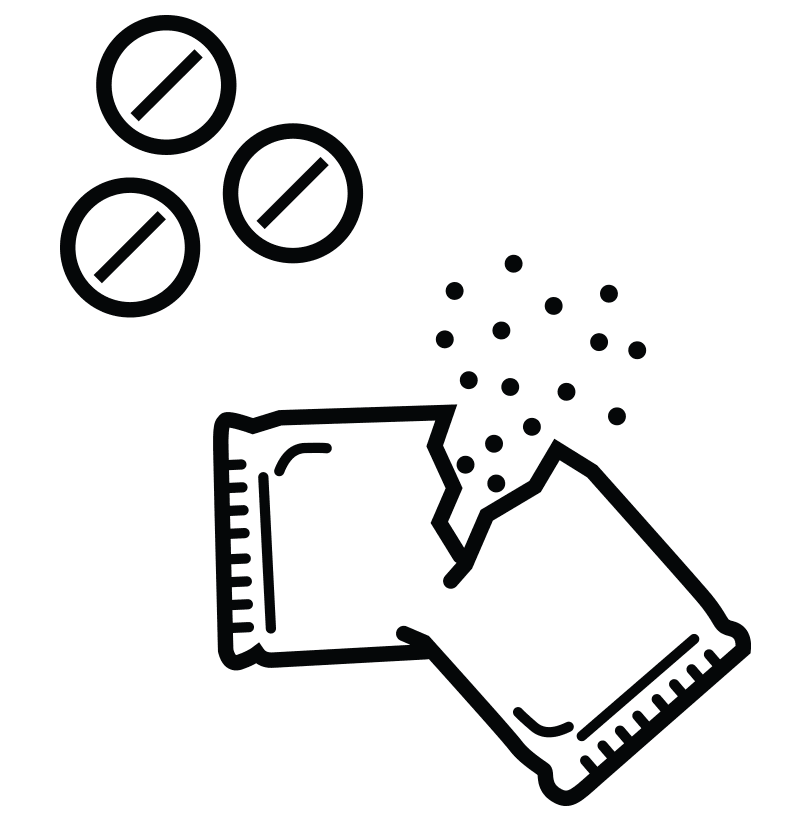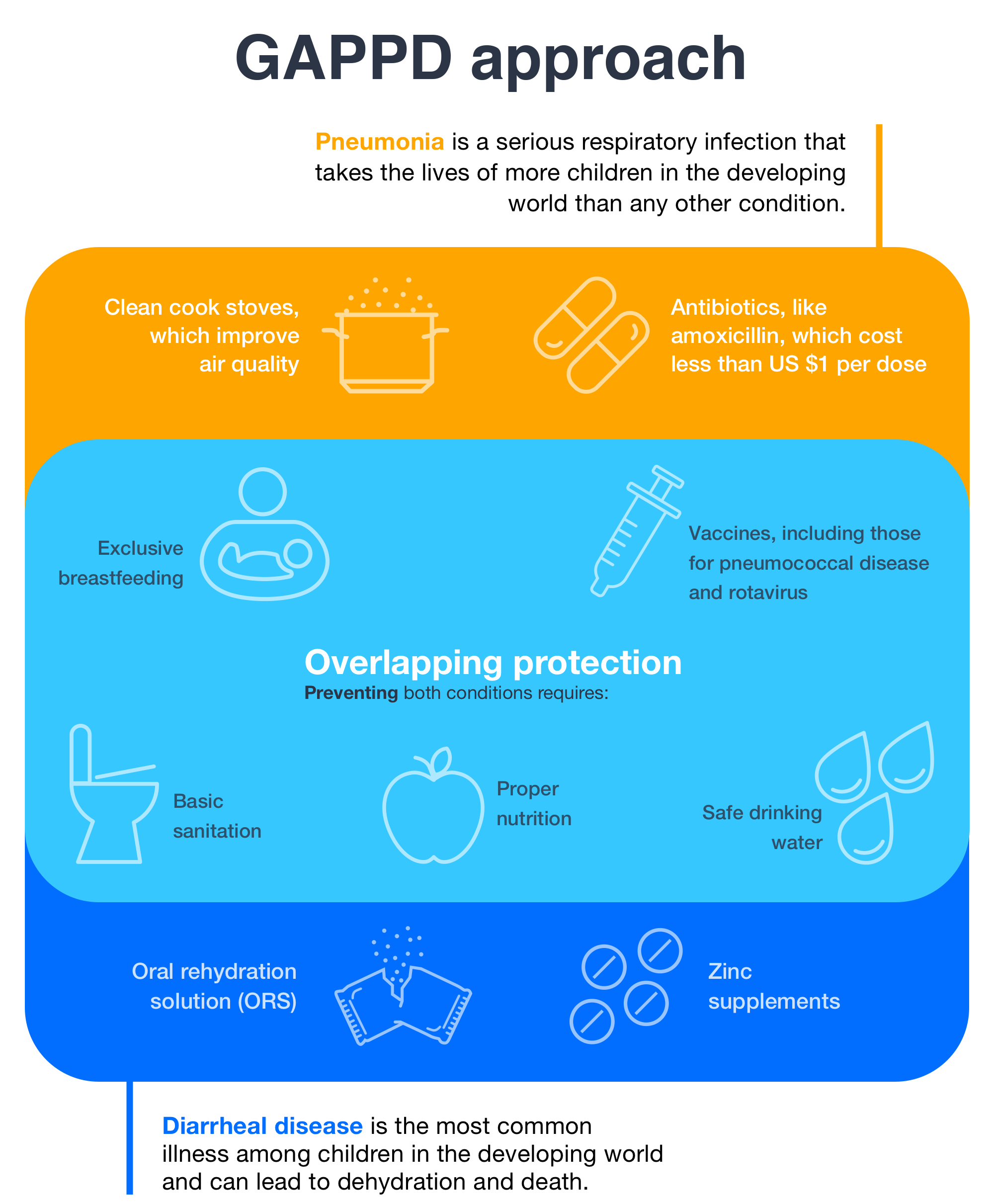Integrated Solutions
Proven solutions exist to prevent and treat diarrhea when infants and young children get sick. Since diarrhea has many causes, and infections can respond differently to treatment, successfully combatting it requires an integrated approach that includes both prevention and treatment solutions.
Vaccines
In settings where medical care can be difficult to access, prevention through vaccination is the best way to protect children.
Learn more.
WASH
Using safe water, properly disposing of human waste, and handwashing with soap help prevent diarrhea.
Learn more.
Breastfeeding & Nutrition
Breast milk is the ideal nourishment for infants, protecting against infections and enabling them to recover more quickly from illness. Proper infant and young child nutrition fortifies the immune system against infectious diseases and promotes healthy, long-term growth and development.
Learn more.
ORS & Zinc
Diarrhea can lead to dehydration, which can become life-threatening. Oral rehydration solution (ORS) is a simple, lifesaving mixture of sugar, water, and salt that replenishes fluids and electrolytes. Zinc reduces the severity and duration of diarrhea infections. It can also prevent future episodes. The World Health Organization (WHO) recommends using ORS and zinc together in diarrhea treatment.
ORS and zinc are frontline treatments. Some cases of severe dehydration may require urgent medical care and intravenous (IV) fluids, which are effective.
Learn more.
It’s not just one intervention. That child deserves to have access to all interventions.
- Dr. Mathu Santosham, Johns Hopkins Bloomberg School of Public Health
YouTube
A comprehensive approach
Combining both prevention and treatment solutions is the most effective way to defeat diarrhea and break the cycle of poor health and poverty for children, families, and communities.
Proven solutions include vaccines, WASH (safe drinking water, sanitation and hygiene), breastfeeding and proper nutrition, and ORS and zinc treatment. Using these solutions together makes them work better. Diarrhea prevention and treatment solutions are complementary. For example, proper sanitation and hygiene go hand-in-hand. Safe drinking water is a necessary component of ORS and complementary feeding. Effectively implementing WASH solutions is critical to addressing the connection between malnutrition and diarrhea. And rotavirus vaccines only prevent diarrheal disease caused by rotavirus, so additional methods are necessary to prevent and treat other forms of diarrhea.
By integrating prevention and treatment solutions, countries can maximize impact, increase efficiency, and reduce costs.
- The use of one solution can help to mobilize the adoption of others. For example, WHO and UNICEF recommend that zinc and ORS be used together to treat diarrhea.
- Combining and implementing solutions together may be more cost-effective, as programs stand to decrease expenses and increase efficiency.
- National policies providing comprehensive options can empower communities and programs to tailor their approaches to meet local needs.
What all we need is to look beyond certain interventions and not work in silos, hoping that things will change by bringing more interventions in one area of the work. Instead, we need to scale the number of interventions at the national level, benefiting all.
- Dr. Paul P Francis, Technical Officer, WHO India
ETHealthWorld
Fighting pneumonia and diarrhea together
Many of the solutions for diarrhea can also fight pneumonia. Together, these two illnesses account for a majority of deaths in children under five years old. Pneumonia and diarrhea share many of the same risk factors, and integrating policies and programs that address both can have a big impact.
Protect, prevent, and treat
Prevention is critical, especially for children without reliable access to care. Most infections occur where treatments can be hard to access—in poor settings or hard-to-reach communities. World Pneumonia Day is November 12. Learn more.
Recognizing the urgency and potential of an integrated approach, WHO and UNICEF issued the Global Action Plan for the Prevention and Control of Pneumonia and Diarrhea (GAPPD) in 2013. It’s the first plan to simultaneously address pneumonia and diarrhea to protect health, prevent illness, and treat affected children.
Child health programs at every level must address diarrhea and pneumonia to make progress toward the Sustainable Development Goals (SDGs) and the United Nations Global Strategy for Women’s and Children’s Health.
The International Vaccine Access Center tracks progress to fight diarrhea and pneumonia in the 15 countries with the highest burden. Check out the latest findings (2023), which detailed progress made in prevention and control efforts of diarrhea and pneumonia.
This is a question of equity. Poor children in low-income countries are most at risk of death from pneumonia or diarrhea but much less likely to get the interventions they need… We know what to do.
- Dr. Mickey Chopra, Lead Service Delivery Specialist, World Bank
UNICEF
Using these solutions together makes them work better:
Further reading:
- Child Health Spotlights (Pneumonia & Diarrhea).
- Countdown to 2030. A Decade of Tracking Progress for Maternal, Newborn and Child Survival: The 2017 Report.
- DefeatDD infographic. Why is diarrhea dangerous?
- DefeatDD.
- DefeatDD. An impossible choice: the dangerous disruption of diarrhea treatment costs.
- DefeatDD. DefeatDD campaigns.
- DefeatDD. How we measure the true impact of diarrheal disease.
- DefeatDD’s new infographic on gut damage makes environmental enteropathy digestible.
- Demographic and Health Surveys. Child Health.
- Every Woman Every Child Report.
- IHME. Global Burden of Disease.
- IHME. Mapping geographical inequalities in childhood diarrhoeal morbidity and mortality in low-income and middle-income countries, 2000–17: analysis for the Global Burden of Disease Study 2017.
- The Lancet. Global, regional, and national causes of under-5 mortality in 2000–15: an updated systematic analysis with implications for the Sustainable Development Goals.
- Thousand Days. The Impact of Poor Sanitation on Nutrition.
- UNICEF/World Health Organization. Ending preventable child deaths from pneumonia and diarrhoea by 2025: The integrated global action plan for pneumonia and diarrhoea (GAPPD).
- UNICEF: Diarrhoea
- United Nations. Sustainable Development Goals.
- World Health Organization. Diarrhoeal disease.
- World Health Organization. Global Strategy for Women's, Children's and Adolescent's Health 2016-2030.



 ORS & Zinc
ORS & Zinc
